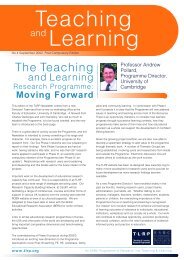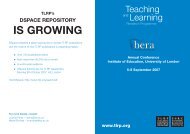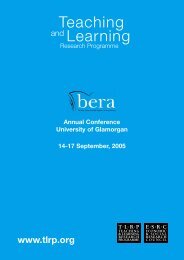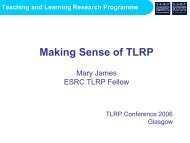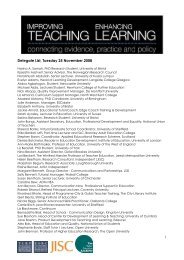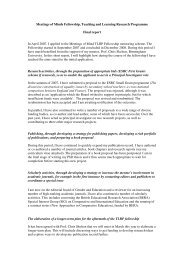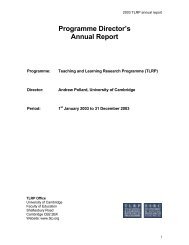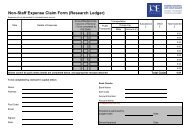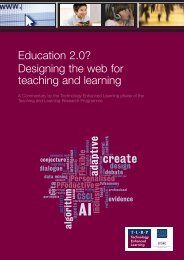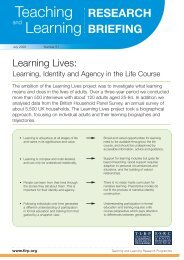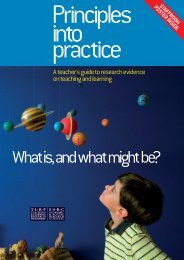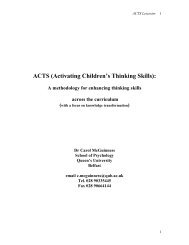Assessment in schools Fit for purpose? - Teaching and Learning ...
Assessment in schools Fit for purpose? - Teaching and Learning ...
Assessment in schools Fit for purpose? - Teaching and Learning ...
You also want an ePaper? Increase the reach of your titles
YUMPU automatically turns print PDFs into web optimized ePapers that Google loves.
Four press<strong>in</strong>g challenges <strong>for</strong> policy-makers<br />
Putt<strong>in</strong>g effective <strong>in</strong>-class assessment <strong>in</strong>to practice system-wide<br />
How effectively is <strong>for</strong>mative assessment, sometimes known as assessment <strong>for</strong> learn<strong>in</strong>g, work<strong>in</strong>g <strong>in</strong> UK<br />
classrooms?<br />
This question has preoccupied researchers <strong>for</strong> many years. The largest study of its k<strong>in</strong>d, the TLRP Learn<strong>in</strong>g<br />
How to Learn <strong>in</strong> Classrooms, Schools <strong>and</strong> Networks project, researched how such practices were developed<br />
by teachers <strong>in</strong> 40 English primary <strong>and</strong> secondary <strong>schools</strong>. All were given some tra<strong>in</strong><strong>in</strong>g. Then it was <strong>in</strong>vestigated<br />
how they implemented assessment <strong>for</strong> learn<strong>in</strong>g <strong>in</strong> practice, <strong>and</strong> what characterised the <strong>schools</strong> where this was<br />
most effective .<br />
The research lasted from 2001 to 2005 <strong>and</strong> <strong>in</strong>cluded surveys of 1,200 school staff <strong>and</strong> 4,000 pupils, <strong>and</strong><br />
detailed <strong>in</strong>terviews <strong>and</strong> observations of 37 teachers’ lessons (27 were filmed). It found that what was def<strong>in</strong>ed as<br />
the “spirit” of assessment <strong>for</strong> learn<strong>in</strong>g was hard to achieve. Although many teachers used techniques associated<br />
with assessment <strong>for</strong> learn<strong>in</strong>g, such as shar<strong>in</strong>g success criteria or <strong>in</strong>creas<strong>in</strong>g “th<strong>in</strong>k<strong>in</strong>g time”, few did so <strong>in</strong> ways<br />
that enabled pupils to become more autonomous learners. This is a def<strong>in</strong><strong>in</strong>g characteristic of assessment <strong>for</strong><br />
learn<strong>in</strong>g <strong>and</strong> learn<strong>in</strong>g how to learn. Some 20 per cent of teachers were, however, identified as captur<strong>in</strong>g its spirit,<br />
which showed that it is possible.<br />
The “spirit” <strong>and</strong> the “letter” of assessment <strong>for</strong> learn<strong>in</strong>g<br />
The TLRP Learn<strong>in</strong>g How to Learn project drew a dist<strong>in</strong>ction between lessons that adopted surface<br />
procedures <strong>and</strong> those that truly captured the deeper pr<strong>in</strong>ciples of <strong>for</strong>mative assessment.<br />
Two English teachers were filmed teach<strong>in</strong>g separate Year 8 classes (13 year olds). They were both<br />
attempt<strong>in</strong>g to do similar th<strong>in</strong>gs <strong>in</strong> similar contexts. In both lessons, the teachers shared the criteria with the<br />
pupils by giv<strong>in</strong>g them a model of what was needed. The pupils then used those criteria to assess the work of<br />
their peers. These elements are central to assessment <strong>for</strong> learn<strong>in</strong>g.<br />
In lesson A, pupils looked at a letter they had written based on a Victorian short story. The teacher modelled<br />
the criteria by giv<strong>in</strong>g the pupils a piece of writ<strong>in</strong>g that was full of errors. They were asked to correct it on their<br />
own. The teacher then went through the corrections with the whole class be<strong>for</strong>e ask<strong>in</strong>g them to read through<br />
<strong>and</strong> correct the work of their peers.<br />
In lesson B, the pupils were asked to consider a dramatic rendition of a n<strong>in</strong>eteenth century poem. The<br />
teacher <strong>and</strong> the classroom assistant per<strong>for</strong>med the poem to the class <strong>and</strong> <strong>in</strong>vited the pupils to critique their<br />
per<strong>for</strong>mance. From this activity the class as a whole, guided by the teacher, established the criteria. These<br />
criteria then governed both the pupils’ th<strong>in</strong>k<strong>in</strong>g about what was needed when they acted out the poem<br />
themselves <strong>and</strong> the peer assessment of those per<strong>for</strong>mances.<br />
Lesson A was an example of assessment <strong>for</strong> learn<strong>in</strong>g be<strong>in</strong>g followed to the letter, because pupils were only<br />
be<strong>in</strong>g taught how to guess what the teacher was look<strong>in</strong>g <strong>for</strong> <strong>in</strong> correct answers. Lesson B followed the<br />
spirit of assessment <strong>for</strong> learn<strong>in</strong>g, because the sequence of activities helped them to learn how to learn <strong>for</strong><br />
themselves.<br />
Source:<br />
Marshall, B. & Drummond, M-J. (2006) How teachers engage with assessment <strong>for</strong> learn<strong>in</strong>g: lessons from the<br />
classroom, Research Papers <strong>in</strong> Education, 21(2): 133-149.



